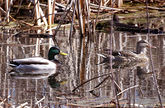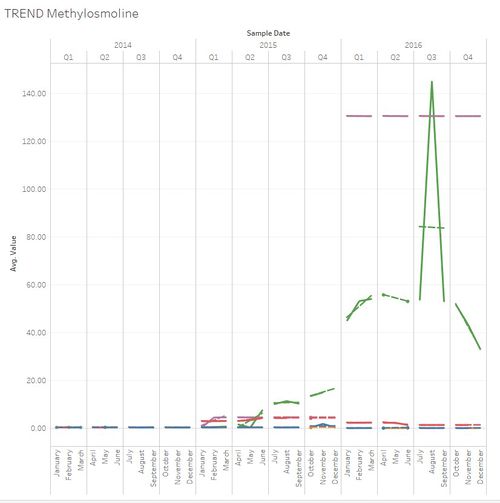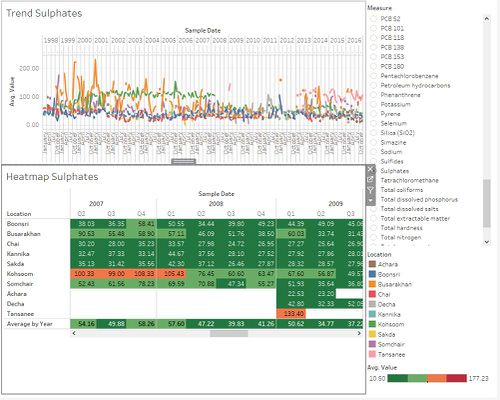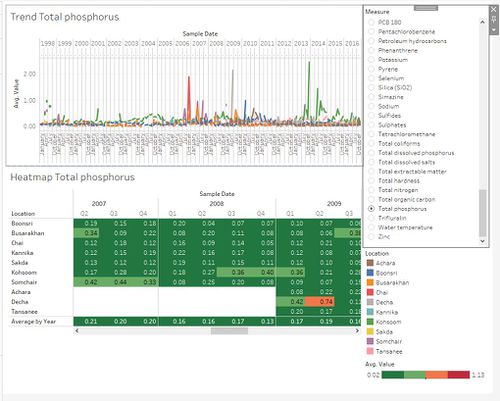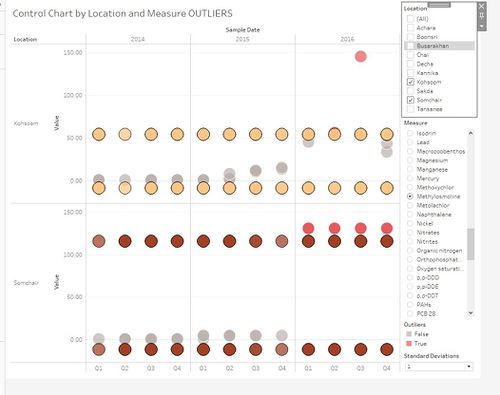Difference between revisions of "ISSS608 2017-18 T3 Assign Alejandro Llorens Moreno Visualization"
| Line 25: | Line 25: | ||
<br/> | <br/> | ||
| − | <font size="5"><font color="#8B4513">''' | + | <font size="5"><font color="#8B4513">'''Insights and answers to questions'''</font></font> |
| − | == | + | ==Trends: Do you see any trends of possible interest in this investigation? == |
| − | |||
<table border='1'> | <table border='1'> | ||
<tr> | <tr> | ||
| Line 35: | Line 34: | ||
</tr> | </tr> | ||
<tr> | <tr> | ||
| − | <td><b> 1. | + | <td><b> 1. Hight levels of Methylosmoline detected ” </b> |
| − | <br> | + | <br>There’s a sharp increase in Methylosmoline levels in 2016 in both Kohsoom and Somchair. Averages increase sharply in the 4 quarters of 2016. This is of particular concern because it’s the contaminant agent. This requires more investigation. In all samples of Methylosmoline for all quarters the measurement is of 130 approx for Somchair and 50 for Kohsoom. This is considerably higher than the average of 22.32 in Kohsoom and 53.50 in Somchair for the last 3 years. |
| − | |||
</td> | </td> | ||
| − | <td>[[File: | + | <td>[[File:Methyl.jpg|500px|center]]</td> |
</tr> | </tr> | ||
<tr> | <tr> | ||
| − | <td><b>2. | + | <td><b>2.Water temperature has been increasing </b><br>Water temperature is cyclical and warmer in the months from June to September (summer). However, in 2016 there’s a higher average water temperature in all locations. To be specific, in 1998 the average water temperature in all locations was 12.95 degrees. While in 2013 is 13.89, in 2014 is 14.79, in 2015 is 14.09 and in 2016 is 14.74 degrees. Global warming and other external causes can obviously affect this measurement, however, it’s worth exploring further..</td> |
| − | <td>[[File: | + | <td>[[File:watertemp2.jpg|500px|center]]</td> |
</tr> | </tr> | ||
<tr> | <tr> | ||
| − | <td><b>3. | + | <td><b>3.There's been drastic changes in Sulfates</b> |
| − | <br> | + | <br> We can see a clear trend in the years after 2007 until 2012 when the average measurement for Sulphates is lower for all locations. But specifically in Kohsoom , Somchair and Busarakhan. |
| − | <td>[[File: | + | </td> |
| + | <td>[[File:SulfatesAlex2.JPG|500px|center]] | ||
</tr> | </tr> | ||
<tr> | <tr> | ||
| − | <td><b>4. | + | <td><b>4.Other chemical changes </b> |
| − | <br> | + | <br>TLooking at Arsenic, Iron and Aluminium, we can determine there’s a huge release of these heavy metals: Arsenic in 2009 for all locations and specifically in 2010 for Kohsoom. Aluminium in Q2 2009. Iron in Q3 2003. Phosphorus peaks in different locations in 2006, 2009, 2014. This is a clear sign of drastic changes in soil or water. It's worth investigating all chemical changes. |
| − | + | ||
| − | + | </td> | |
| − | + | <td>[[File:Otherchemicals.JPG|500px|center]] | |
| − | |||
| − | |||
| − | |||
| − | |||
| − | |||
| − | |||
| − | |||
| − | <td>[[File: | ||
</tr> | </tr> | ||
| + | |||
</table> | </table> | ||
| − | == | + | ==Anomalies: What anomalies do you find in the waterway samples dataset? How do these affect your analysis of potential problems to the environment? Is the Hydrology Department collecting sufficient data to understand the comprehensive situation across the Preserve? What changes would you propose to make in the sampling approach to best understand the situation? == |
| − | |||
<table> | <table> | ||
<table border='1'> | <table border='1'> | ||
| Line 101: | Line 92: | ||
</table> | </table> | ||
| − | == | + | ==Causes of concern: do any of your findings cause particular concern for the Pipit or other wildlife? Would you suggest any changes in the sampling strategy to better understand the waterways situation in the Preserve? == |
| − | |||
| − | |||
| − | |||
| + | <br> | ||
<table> | <table> | ||
<table border='1'> | <table border='1'> | ||
<tr> | <tr> | ||
| − | <th> | + | <th> Causes of Concern ID</th> |
<th>Visualization</th> | <th>Visualization</th> | ||
</tr> | </tr> | ||
<tr> | <tr> | ||
| − | <td> | + | <td> |
| − | <br>a | + | <br>I have created a control chart to represent outliers in 1,2 or 3 standard deviations and show specific outliers in the data. Of particular concern is the contaminant chemical Methylosmoline. |
| − | + | <td>The figure below shows the outliers of 1 standard deviation of Methylosmoline in two locations: Kohsoom and Somchair | |
| − | <td>The | + | [[File:Concern.JPG|500px|center]]</td> |
</tr> | </tr> | ||
<tr> | <tr> | ||
Revision as of 09:37, 8 July 2018
|
|
|
|
|
Insights and answers to questions
Trends: Do you see any trends of possible interest in this investigation?
| Patterns | Visualization |
|---|---|
| 1. Hight levels of Methylosmoline detected ”
|
|
| 2.Water temperature has been increasing Water temperature is cyclical and warmer in the months from June to September (summer). However, in 2016 there’s a higher average water temperature in all locations. To be specific, in 1998 the average water temperature in all locations was 12.95 degrees. While in 2013 is 13.89, in 2014 is 14.79, in 2015 is 14.09 and in 2016 is 14.74 degrees. Global warming and other external causes can obviously affect this measurement, however, it’s worth exploring further.. |
|
| 3.There's been drastic changes in Sulfates
|
|
| 4.Other chemical changes
|
Anomalies: What anomalies do you find in the waterway samples dataset? How do these affect your analysis of potential problems to the environment? Is the Hydrology Department collecting sufficient data to understand the comprehensive situation across the Preserve? What changes would you propose to make in the sampling approach to best understand the situation?
| Patterns | Visualization |
|---|---|
| 1.Campers
Fig 7 provides the yearly visitor traffic calendar for the campers. The campers visited the reserve more often from May to Aug, possibly because this is the warm period of the year. The highest traffic of campers was observed in July 2015. There is a drastic drop in the campers, especially extended campers, from Q4 2015 onwards, which could be attributed to the colder weather. |
|
| 2. Rangers Trend
In Fig 8.2 we could see the rangers gathered at the rangerbase and gate 8 (which is in close proximity to the ranger base) on Thursdays 14pm. It could be an indication that the weekly ranger meetings were held on Thursdays 14pm at the rangerbase. |
|
| 3.Service Trucks
Fig 9 below shows the weekly movement pattern for service trucks at various gates. We noticed that there were a higher number of service trucks moved pass the “connecting path” on Thursdays, at two prominent timings: 1am and 16pm. This might be the scheduled delivery/pick up hours for the service trucks. |
|
| 4. Sightseeing coaches
-Fridays & Sundays 3am -Thursdays & Sundays 11am -Sundays 16pm -Mondays 22 pm |
Causes of concern: do any of your findings cause particular concern for the Pipit or other wildlife? Would you suggest any changes in the sampling strategy to better understand the waterways situation in the Preserve?
| Causes of Concern ID | Visualization |
|---|---|
|
| The figure below shows the outliers of 1 standard deviation of Methylosmoline in two locations: Kohsoom and Somchair |
| 2.b.4 vehicle entered from entrance 3 trespassing restricted areas (gate5,gate6,rangerstop6,gate3 & ranger stop 3) 23 times from 2am to 5 am, only observed on Tuesdays and Thursdays. The trespassing cars followed almost exactly the same paths. This looks like some planned acts which were only performed under the masks of the dark night. Type 4 vehicles are the heavy trucks; they could be transporting some illegal materials in or out of the preserve repeatedly. | The gif below shows the paths adopted by the suspicious vehicles,the restricted gates are colored in red. |
| In 12.2, we kept only the “extended campers” and included all the gates in the analysis. We noticed some suspicious movements of the extended campers at 0 hours which the rest of the extended campers would not be active at this hour. Interestingly, we noticed all the activity records belong to the car ID 20154519024544-322, which stayed in the preserve for 5 months. |
Stay Duration Anomaly
In the “Stay Duration Anomaly” dashboard we introduced two scatter plots for anomaly discovery.
| Anomalies & Car ID | Visualization |
|---|---|
| 4.Abnormally high number of stops visited with low average duration
• 20150105060134-242, 20150420100416-232 visited 4 checkpoints but stayed for over one month in the reserve (Extended camper) |
|
| 6.Hiking or sightseeing visitors with abnormally long stay in the park (they are the same group of visitors observed in 1)
|
